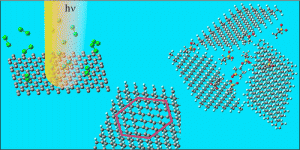Halogenated Graphenes: Rapidly Growing Family of Graphene Derivatives

The authors of RCPTM František Karlický, Kasibhatta Kumara Ramanatha Datta , Michal Otyepka , and Radek Zbořil have published paper in ACS Nano. The paper is entitled “Halogenated Graphenes: Rapidly Growing Family of Graphene Derivatives”
ACS Nano, 2013, 7 (8), pp 6434–6464, IF=12,062, DOI: 10.1021/nn4024027
Abstract:
Graphene derivatives containing covalently bound halogens (graphene halides) represent promising two-dimensional systems having interesting physical and chemical properties. The attachment of halogen atoms to sp2 carbons changes the hybridization state to sp3, which has a principal impact on electronic properties and local structure of the material. The fully fluorinated graphene derivative, fluorographene (graphene fluoride, C1F1), is the thinnest insulator and the only stable stoichiometric graphene halide (C1X1). In this review, we discuss structural properties, syntheses, chemistry, stabilities, and electronic properties of fluorographene and other partially fluorinated, chlorinated, and brominated graphenes. Remarkable optical, mechanical, vibrational, thermodynamic, and conductivity properties of graphene halides are also explored as well as the properties of rare structures including multilayered fluorinated graphenes, iodine-doped graphene, and mixed graphene halides. Finally, patterned halogenation is presented as an interesting approach for generating materials with applications in the field of graphene-based electronic devices.

The authors of RCPTM František Karlický, Kasibhatta Kumara Ramanatha Datta , Michal Otyepka , and Radek Zbořil have published paper in ACS Nano. The paper is entitled “Halogenated Graphenes: Rapidly Growing Family of Graphene Derivatives”
ACS Nano, 2013, 7 (8), pp 6434–6464, IF=12,062, DOI: 10.1021/nn4024027
Abstract:
Graphene derivatives containing covalently bound halogens (graphene halides) represent promising two-dimensional systems having interesting physical and chemical properties. The attachment of halogen atoms to sp2 carbons changes the hybridization state to sp3, which has a principal impact on electronic properties and local structure of the material. The fully fluorinated graphene derivative, fluorographene (graphene fluoride, C1F1), is the thinnest insulator and the only stable stoichiometric graphene halide (C1X1). In this review, we discuss structural properties, syntheses, chemistry, stabilities, and electronic properties of fluorographene and other partially fluorinated, chlorinated, and brominated graphenes. Remarkable optical, mechanical, vibrational, thermodynamic, and conductivity properties of graphene halides are also explored as well as the properties of rare structures including multilayered fluorinated graphenes, iodine-doped graphene, and mixed graphene halides. Finally, patterned halogenation is presented as an interesting approach for generating materials with applications in the field of graphene-based electronic devices.


